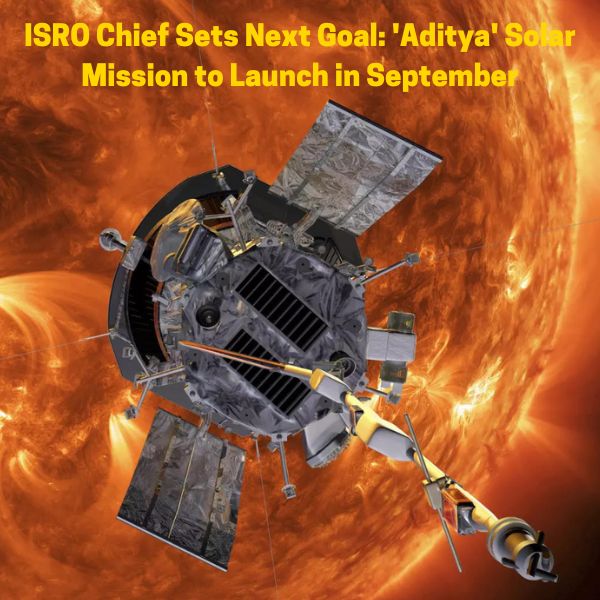
Following the jubilation surrounding the accomplished landing of Chandrayaan-3, ISRO has unveiled its intentions to pursue various new endeavors. Chairman S Somanath officially announced on Thursday that a solar mission is presently under development. Additionally, Prime Minister Narendra Modi hinted at forthcoming missions to the Sun and Venus during a speech delivered after the successful touchdown of the lander on the lunar surface.
In a statement made one day after ISRO’s remarkable achievement of successfully conducting its inaugural lunar landing mission, the ISRO chief revealed that preparations for “Mission Aditya” are underway, with a target launch date set for the first week of September. Additionally, plans are being made for a mission in either September or October to showcase the crew module and crew escape capability, followed by a series of test missions leading up to the eventual launch of the first manned mission to space, Gaganyaan, potentially by 2025.
Aditya-L1: India’s Solar Mission for Watching the Sun from a Special Spot
Aditya L1 is set to be India’s inaugural space-based mission dedicated to studying the Sun. The spacecraft will be strategically positioned in a halo orbit around Lagrange point 1 (L1) within the Sun-Earth system, located approximately 1.5 million km away from Earth.
This strategic location offers an uninterrupted view of the Sun, free from eclipses and blockages. Aditya-L1 is equipped with seven scientific tools that are tailored to explore different aspects of the Sun, such as its photosphere, chromosphere, and corona. These tools employ electromagnetic and particle sensors. While four of these tools directly observe the Sun from the unique vantage point of L1, the remaining three perform on-site examinations of particles and fields present at Lagrange point L1.
Primary Scientific Aims of Aditya-L1 Mission
The Aditya-L1 mission has important goals in the field of science. It wants to learn more about the upper parts of the Sun’s atmosphere like the chromosphere and corona. This includes understanding things like how they move and how they get hot. The mission also wants to know about things called coronal mass ejections and solar flares, which are important for space weather.
Aditya-L1 will also look at particles and plasma around the Sun and learn how they move. It will try to find out how the Sun’s corona gets heated up and what its temperature, speed, and density are. The mission aims to know more about things called coronal loops and how they work.
Another interesting goal of the mission is to understand how things called Coronal Mass Ejections (CMEs) happen and where they come from. It will study how events on different layers of the Sun lead to big events like solar eruptions.
Aditya-L1 will also study the Sun’s magnetic fields and how they work in the corona. The mission will look into things that can impact space weather, like the solar wind’s source and how it behaves.
What motivates the study of the sun?
The sun, being our closest star, presents a unique opportunity for in-depth exploration that is not possible with distant stars. Studying the sun not only provides insights into the stellar population of our Milky Way galaxy but also unveils knowledge about stars in other galaxies.
As a highly dynamic star, the sun extends far beyond its visible form, exhibiting various eruptive activities and releasing immense energy into the solar system. These powerful solar events, if directed towards Earth, can disrupt the space environment near our planet.
Understanding the behavior of the sun is crucial due to the potential disruptions it can cause to spacecraft and communication systems. Early warnings are essential for mitigating the effects of these disturbances. Additionally, exposure to solar outbursts poses risks for astronauts.
The sun’s extreme thermal and magnetic characteristics create a natural laboratory for studying phenomena that cannot be replicated in controlled laboratory environments. This enables researchers to gain a deeper understanding of these intricate processes.
Collaborative Space Endeavor: NASA and ISRO’s NISAR Satellite Advancing Earth Observation
NASA and ISRO, the space agencies of the United States and India respectively, have teamed up to develop a powerful Earth Observation Satellite. This satellite, currently being constructed in Bengaluru, is expected to launch in the early months of the upcoming year. It is called NISAR, which stands for NASA-ISRO Synthetic Aperture Radar. The primary objective of NISAR is to meticulously monitor changes in Earth’s land and ice surfaces. By collecting precise data, NISAR aims to greatly enhance our understanding of crucial global processes such as climate change, deforestation, glacier melt, volcanic activity, and seismic events.
NISAR’s remarkable capability to observe nearly every part of our planet within a 12-day interval will enable a comprehensive study of various natural phenomena. In addition to its primary focus, the satellite will also play a vital role in unraveling the complex dynamics of forests, wetlands, and agricultural lands, thereby contributing valuable insights to our scientific knowledge.









